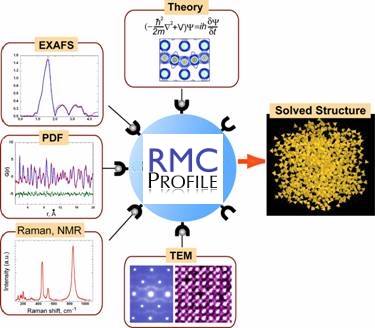Difference between revisions of "Main Page"
| Line 5: | Line 5: | ||
This version of RMC was built from the original RMCA code of McGreevy & Pusztai to determine the local structure of crystalline materials while still being capable of analyzing disordered systems. The current version of RMCProfile results from a collaboration between scientists at ISIS, University of Cambridge, University of Oxford & NIST[http://www.nist.gov/mml/ceramics/structure_determination/measurement-and-prediction.cfm]. It is now possible to fit many data types simultaneously (Neutron & X-ray total scattering & the Bragg profile, EXAFS, single crystal diffuse scattering) and use a range of constraints to produce atomic models that are consistent with all the available data. In this way we are progressing the effort to develop a 'complex modelling' approach to elucidate structural details of materials that are the key to their exploitable functional properties. | This version of RMC was built from the original RMCA code of McGreevy & Pusztai to determine the local structure of crystalline materials while still being capable of analyzing disordered systems. The current version of RMCProfile results from a collaboration between scientists at ISIS, University of Cambridge, University of Oxford & NIST[http://www.nist.gov/mml/ceramics/structure_determination/measurement-and-prediction.cfm]. It is now possible to fit many data types simultaneously (Neutron & X-ray total scattering & the Bragg profile, EXAFS, single crystal diffuse scattering) and use a range of constraints to produce atomic models that are consistent with all the available data. In this way we are progressing the effort to develop a 'complex modelling' approach to elucidate structural details of materials that are the key to their exploitable functional properties. | ||
| − | |||
{| | {| | ||
Revision as of 23:09, 15 February 2013
RMCProfile : Reverse Monte Carlo for crystalline and disordered materials
Welcome to the home of RMCProfile, here you can download the RMCProfile software, documentation and examples.
This version of RMC was built from the original RMCA code of McGreevy & Pusztai to determine the local structure of crystalline materials while still being capable of analyzing disordered systems. The current version of RMCProfile results from a collaboration between scientists at ISIS, University of Cambridge, University of Oxford & NIST[1]. It is now possible to fit many data types simultaneously (Neutron & X-ray total scattering & the Bragg profile, EXAFS, single crystal diffuse scattering) and use a range of constraints to produce atomic models that are consistent with all the available data. In this way we are progressing the effort to develop a 'complex modelling' approach to elucidate structural details of materials that are the key to their exploitable functional properties.
|
To download the software you will need an account on this site. I'm afraid due to the site being hacked you will have to email me to set one up, until I get the new system running. I'm afraid it will not be possible to support users who are working with versions of the software that are not the current version.
(Please note this account is distinct from your RMC Forum [2] account; should you have one you will still need to set up a separate RMCProfile account.)
If you have problems accessing the site please email Matt Tucker.


